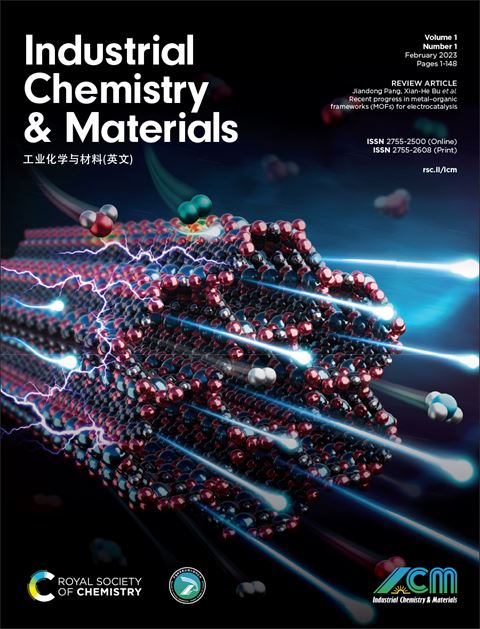Isolation of anhydrous tetrabutylphosphonium lanthanide hexa- and penta-nitrates from ionic liquids
Integrating Green Chemistry into Chemistry Education
Integrating Green Chemistry into chemistry education is more important than ever. It is really critical that we implement aspects of Green Chemistry and Education in chemistry curricula at all levels.
Prof. Mudring had the honor of hosting Jamie Ferguson as a guest professor in the Intelligent Advanced Materials group at Aarhus University for her sabbatical, where she also gave the Sigma Aldrich Green Chemistry lecture on implementing green chemistry in higher education. This is just one example of how collaborations in Green Chemistry around the globe are growing stronger. Fighting global challenges needs global efforts – and a highly knowledgeable, educated workforce.
Integrating Green Chemistry into Chemistry Education

New publication from the Rogers-Mudring collaboration
The Rogers-Mudring collaboration is going strong. Just published are new results from the collaboration that establish solid design guidelines for ionic liquids. This work was also part of Dr. Olivier Renier’s PhD thesis.
You can read the article here.
New Open Framework Material Discovered!
The Mudring group and collaborators have described a new class of open framework materials (OFMs). OFMs, such as zeolites, contain voids in their structures that give them attractive functionalities including catalysis, gas storage, separation and ion exchange. The framework structures of practically all known inorganic OFMs are restricted to tetrahedral building blocks, such as silicate (SiO44-). In their paper, however, the authors describe their discovery of a whole new class of OFMs with exclusively octahedral building blocks forming the open framework. The octahedral building blocks of these new compounds are reminiscent of the zero-dimensional units that form polyoxometalates (POMs), which are known for their interesting magnetic properties. Repeating those units in three dimensions in an open framework make the authors’ new OFMs interesting for new applications in magnetics, like spintronics for the green transition.
The authors’ approach to synthesising these new materials is key. The use of ionic liquids – that act as the reaction medium, mineralizer, and templating agent – allows for the formation of the open framework instead of dense phases that form by using traditional solvents.
Read the article here.

New Green Transition Research Funding
Danmarks Frie Forsknings Fond (Independent Research Fund Denmark) has just funded AVM’s Green Transition project Enabling energy-efficient refrigeration through new magnetocaloric materials

About the project: Household and commercial refrigeration is responsible for 17% of global electrical energy consumption. It is estimated that by 2030, 13% of global greenhouse gas emissions will be due to refrigeration, unless a revolutionary technology comes along. With respect to conventional cooling, magnetic cooling is a transformational technology where 75% efficiency can be reached. Magnetic cooling does not rely on environmentally hazardous refrigerants such as fluorocarbons or chlorofluorocarbons, which are known to contribute to global warming. Despite the great energy saving potential of magnetic cooling, the technology is not widely used, as there is a lack of materials that demonstrate the magnetocaloric effect. We aim to close this gap through a systematic exploration of the most promising systems that demonstrate efficacy.
More Cover Material
The Mudring group’s work with Ukrainian collaborators made it to the cover of the Journal of Solid State Chemistry!

Crystal structures from collaborations
Crystal structures with symmetry are the art of nature – the electronic structure has its beauty, too. Read more about our results from a long-standing collaboration with colleagues from the Ivan Franko National University of Lviv, Ukraine:
Crystal and electronic structures of a new hexagonal silicide Sc38Co144Si97

Developing luminescent nanomaterials that can meet the application needs for a sustainable society
A new publication from the group Phonon-Mediated Nonradiative Relaxation in Ln3+-Doped Luminescent Nanocrystals tackles the unsatisfactory photoluminescence efficiency of Ln3+-doped nanocrystals that severely restricts their practical application. The publication shows that phonon-mediated nonradiative relaxation in Ln3+-doped nanocrystals is substantially influenced by a variety of factors. Moreover, without explicit knowledge and consideration of these factors, property analysis will probably end up with misinterpretation. Thus the use of knowledge established for bulk materials to interpret the experimental findings collected at the nanoscale should be cautiously scrutinized. The authors conclude that systematic studies are needed for the informed development of Ln3+-doped luminescent nanomaterials that can meet the application needs for a sustainable society.
Latest publication
Frustration and 120° Magnetic Ordering in the Layered Triangular
Antiferromagnets AFe(PO3F)2 (A = K, (NH4)2Cl, NH4, Rb, and Cs)

The newest publication from the Mudring group is here! The paper presents a new family of layered iron oxofluorophosphates, AFe(PO3F)2, that were made by ionothermal methods using PF6 ionic liquids. In the context of frustrated triangular antiferromagnets, the close structural relationship between the layered compounds as well as polymorphism enables studying the magnetic properties as a function of cation identity and crystal symmetry.
New journal: Industrial Chemistry and Materials

